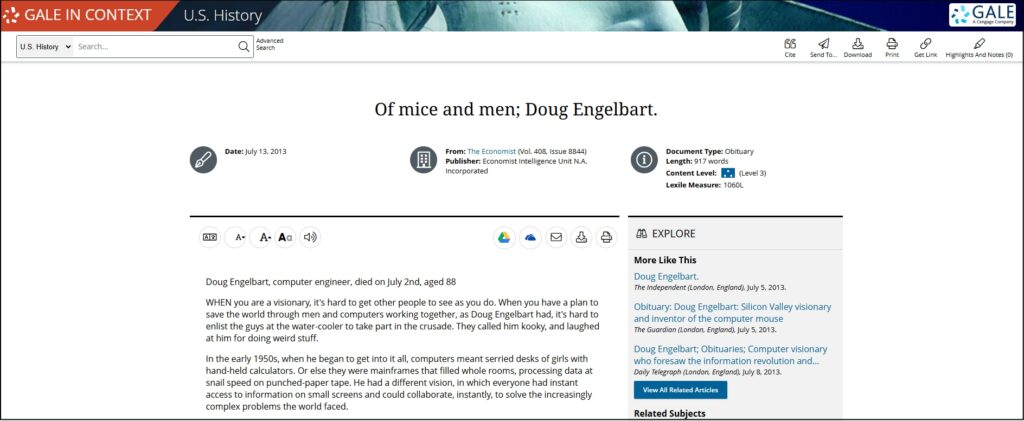| By J. Robert Parks |
Douglas Engelbart, who was born one hundred years ago this week on January 30, 1925, is hardly a household name like other titans of the computer world, such as Steve Jobs and Bill Gates—but he should be. So much of what we take for granted in personal computers (and indeed, the modern internet) owe their existence to Engelbart. The computer mouse, graphical user interfaces, hypertext—he created them all. Teachers and librarians who want to help students understand the importance of Engelbart, as well as the history of modern computers and the internet, will find a wealth of resources in Gale In Context: U.S. History.
Engelbart was born in Portland, Oregon. After serving in the military during World War II, he graduated from college and eventually earned his Ph.D. in electrical engineering at the University of California, Berkeley in 1955. He had become fascinated by computers, but his colleagues at Berkeley told him that his ideas were too esoteric for any kind of academic success, so he moved to the Stanford Research Institute in 1957. There, he worked on a variety of subjects, including miniaturizing computer parts. In fact, his early paper “Microelectronics and the Art of Similitude” is seen as an early inspiration for Moore’s Law.
Another of Engelbart’s early writings was Augmenting Human Intellect: A Conceptual Framework, written as a report for the institute in 1962. He argued that because problems were becoming more and more complex, it was critical that organizations and businesses create environments in which people could work together more effectively, as well as with machines that could augment their abilities. To that end, Engelbart envisioned computers that people could interact with, rather than simply the mainframes, computing devices, and punch cards that were the norm in the 1950s and early 1960s.
But how would people interact with such machines? Engelbart realized that the user somehow had to be able to connect with the computer’s cursor, to be able to move it in a way that allowed the user to interact with what was on screen. We take that for granted today, but it really was a significant hurdle. In 1964, Engelbart made a sketch of what he had in mind and asked a colleague to make a hand-controlled tracking device that would allow movement as well as buttons that you could press. The result was the world’s first mouse. Later he would admit, “I don’t know why we call it a mouse. … It started that way and we never did change it.”
By 1968, Engelbart had refined his mouse and graphical user interface to the point where he was ready to show engineers what was possible. On December 8, 1968, in a famous presentation now known as “the mother of all demos,” Engelbart showcased his ideas to an audience of a thousand engineers in San Francisco. He projected what he was doing on the computer from a screen that people could watch. Instead of using punch cards, he typed on the screen. When he made a mistake, he simply deleted what he had written. He also copied text and pasted it. He moved words around. He clicked a link on the screen, and another document opened. All of these now-mundane actions were revolutionary.
What might have been most revolutionary of all of Engelbart’s innovations, however, was hypertext, the ability to link to different pieces of information located on various computer networks, so that other people can access that information whenever they want (examples of which are helpfully scattered through this blog). If that sounds like the internet to you, you’re right. Engelbart didn’t invent the idea of hypertext or the internet, but he made it possible, and he foresaw the impact that hypertext could have on augmenting human abilities and creating the kinds of communities that have sprung up on the web.
About the Author
J. Robert Parks is a former professor and frequent contributor to Gale In Context: U.S. History and Gale In Context: World History who enjoys thinking about how our understanding of history affects and reflects contemporary culture.



